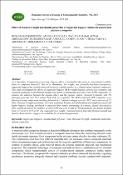Options
Effect of flexural strength and density properties of sugarcane bagasse reinforced unsaturated polyester composites
Journal
Romanian Journal of Ecology & Environmental Chemistry
ISSN
2668-5418
Date issued
2025-07-15
Author(s)
Shamsuddeen, Ruslan
Haruna, Aminu Sanusi
National Defense College Abuja, Nigeria
Abdulkadir, Ziyaulhaq Auwal
Bayero University Kano
Faruq, Hussaini
College of Agriculture Mokwa, Nigeria
Adam, Ansar Bilyaminu
Abubakar, Musa Yahaya
Usmani, Mohammed Alhaji
Umar Suleiman College of Education Gashua, Nigeria
DOI
10.21698/rjeec.2025.105
Abstract
As a byproduct of sugarcane processing, bagasse offers a sustainable alternative to conventional synthetic fibers in composite materials. Due to its abundance, low weight, and favorable mechanical properties, sugarcane bagasse has recently attracted increased scientific interest as a reinforcement in plastic composites. This study investigated the effects of sugarcane bagasse (SCB) weight fraction, particle size variation, and chemical treatments on the flexural strength and density of unsaturated polyester resin (UPR) composites. To enhance the adhesion between the bagasse fibers and the polymer matrix, chemical treatments with 5% hydrogen peroxide and 10% sodium hydroxide were applied. The SCB-reinforced UPR composites were fabricated using compression molding, followed by a 5-minute curing process at 130°C and a pressure of 2.5 MPa. Flexural strength and density were then evaluated. Results showed that flexural strength increased with higher bagasse loading, attributed to improved fibber–matrix intermixing. In contrast, density decreased as fibber content increased; for instance, at 100% UPR and 25% weight of 710 µm particles, the density dropped from 1.37 g/cm³ to 0.55 g/cm³. The composite's low weight, combined with its favourable flexural strength and density characteristics, suggests its suitability for structural applications.
Files
Loading...
Name
Articol 05 Full.pdf
Size
335.14 KB
Format
Adobe PDF
Checksum
(MD5):1d124e6002c3f9b263f0a8d4cfc48d37